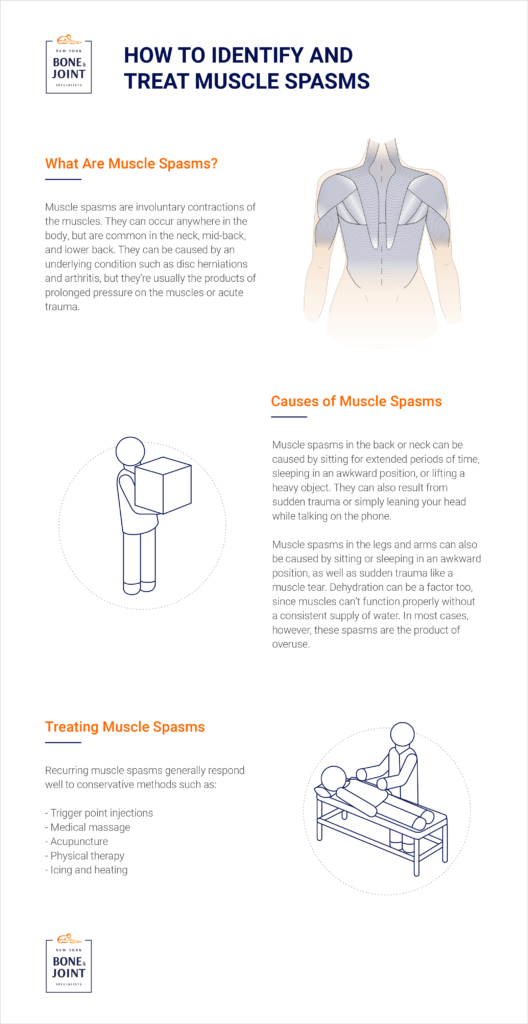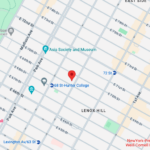Living in New York City has many benefits. You can walk everywhere—to work, to the gym, to a restaurant for a night out with friends. No doubt New Yorkers live a fast-paced, sometimes stressful lifestyle. Yet rushing from one place to another puts New Yorkers at risk for muscle spasms, an involuntary and painful contraction of the muscles.
Another factor possibly leading to muscle spasms is that most New Yorkers sit for long periods at desk jobs. Latest statistics estimate nearly 60 percent of office workers in the Big Apple are now back at their desks following the pandemic.
When muscle spasms strike, New Yorkers can count on the expertise of the muscle spasm doctors and physical therapists at New York Bone & Joint Specialists to find ways to relieve the spasms and pain.
We are leaders in treating muscle spasms with a comprehensive approach to diagnosing and treating musculoskeletal conditions. Our knowledge and experience in muscle spasms ensure you get the finest treatment to help you overcome muscle spasms and return to your work and play as soon as possible.
Understanding Muscle Spasms: What Causes These Painful Episodes?
Your body contains more than 600 muscles, the soft tissues that keep your body moving. Made up of thousands of small fibers, your muscles stretch and move your organs and skeletal system. Some movements are voluntary, meaning your nervous system initiates action on your behalf. Other muscle movements, like your heart beating, are automatic—you don’t have to think about them.
Muscle spasms are involuntary contractions of a muscle. They can occur anywhere in the body but are very common in the neck, legs, mid- and lower back, and abdomen. You’ll feel a sharp pain and abrupt tightening of the muscle. The spasm is usually short in duration, lasting seconds to 15 minutes.
Also called a cramp or charley horse, muscle spasms affect an estimated 50 to 60 percent of adults. Reasons for a muscle spasm include:
Dehydration and electrolyte imbalance. Not drinking enough water or having a deficiency in essential minerals such as potassium, magnesium, and calcium.
Overuse and muscle fatigue. High-intensity exercise in the heat without rest or hydration depletes fluid from the muscles.
Poor posture and ergonomics. Sitting at a desk for long periods in an improper position.
Nerve compression. A herniated disc in the back can cause muscle spasms by pinching a nerve.
Stress and tension. Prolonged stress and anxiety can tighten muscles.
Medications. Certain medications for high blood pressure can deplete essential minerals.
Underlying medical conditions. Chronic health conditions such as kidney disease, diabetes, and neuropathy.
Acute vs. Chronic Muscle Spasms
Acute muscle spasms are typically the result of overuse, muscle strain, dehydration, or an injury. Short-lived, acute muscle spasms are relieved by rest, gentle stretching, and massage. Chronic muscle spasms may indicate a serious underlying condition, such as nutrient deficiency, restricted blood flow, or a neurological disorder like multiple sclerosis. If the muscle spasms cause severe pain, muscle weakness, swelling, and persist after self-care, see a doctor for further evaluation.
Types of Muscle Spasms by Location: Symptoms and Impact
Back Muscle Spasms and Lower Back Muscle Spasms
Back muscle spasms are one of the most common types of muscle spasms. Muscle spasms in the back can be caused by sitting for extended periods at an office desk, sleeping in an awkward position, or carrying a heavy object along the street and in the subway. Trauma to the back or a herniated disc can also cause back spasms.
The muscle spasm may feel like a sudden, sharp pain or a dull ache. The spasm may tighten the muscle to the point where it’s rigid and restricts mobility in the back, making walking painful.
Neck Muscle Spasms
Neck muscle spasms are also common, particularly among office workers who spend hours looking at their computer screens. It also affects anyone who tilts their head and neck toward a smartphone or tablet, leading to what is known as “tech neck.” An injury to the head and neck can cause muscle spasms due to whiplash. The stress of commuting in the city can tense muscles and prompt spasms. Sleeping in a rigid position can also cause neck spasms.
Neck pain and stiffness are the primary symptoms of neck spasms, which can make rotating your neck, head, and shoulders difficult.
Abdominal Muscle Spasms
Less common, abdominal muscle spasms are contractions of the abdominal muscles, stomach muscles, and intestines. The spasm may feel like a slight twitch or a cramp.
Dehydration or a muscle strain usually causes an abdominal cramp or spasm. However, severe and persistent cramping and pain accompanied by intestinal issues (diarrhea, constipation, bloating) could be a sign of inflammatory bowel disease.

Other Common Locations
Muscle spasms in legs. Muscle spasms in the legs can be caused by extended sitting or sleeping in an awkward position. Dehydration can also be a contributing factor, since a muscle can’t function properly without a consistent supply of water. In most cases, however, these spasms are the product of overuse.
Muscle spasms in arms. As with muscle spasms in the legs, muscle spasms in the arms are often caused by overuse or dehydration, but they can also be triggered by sudden trauma such as a muscle tear.
Facial muscle spasms. Spasms may only affect one side of the face and feel like a twitch. Causes range from a blood vessel touching a nerve to a tumor. In some cases, there is no known cause.
When to See a Muscle Spasm Doctor
Muscle spasms are usually temporary and resolve in a few minutes or with at-home care. Yet indications of a more serious underlying condition must be checked by one of the expert muscle spasm specialists at New York Bone & Joint Specialists.
Chronic spasms. Spasms persist after at-home care and become chronic.
Neurological symptoms. Numbness, pain, muscle weakness, vision issues, and difficulty sleeping.
Quality of life. Difficulty with walking and coordination.
The symptoms listed above must be seen immediately by a specialist. New York Bone & Joint Specialists has several locations around the city for appointments and walk-in emergency patients. We accept many leading insurers.
Comprehensive Muscle Spasm Diagnosis
What to expect during your initial consultation with one of our muscle spasm doctors:
- Review of your medical history and medications
- Questions about when symptoms began, how painful they are, and their duration
- Assessment of possible connections to your work and lifestyle
- Analysis of your posture and gait
- Discussion of any neurological symptoms, such as numbness and vision problems
- A blood test to determine any deficiencies in essential minerals like potassium, calcium, sodium, and magnesium
- Imaging tests (X-ray, MRI, CT scan) to view any narrowing of the blood vessels, structural, or soft tissue abnormalities
- An electromyography (EMG) to determine the muscle’s response to electrical stimulation. This would be done to rule out nervous system disorders, such as MS
Advanced Muscle Spasm Treatment Options
When a spasm hits, try these various treatments:
Immediate Relief Treatments
Muscle relaxant medications. Prescription muscle relaxers can relieve pain but may cause side effects such as drowsiness and nausea.
Anti-inflammatory medications. To alleviate soreness after a cramp, take ibuprofen, naproxen, or aspirin.
Gentle stretching. Gently stretch the tight muscle. For a calf cramp, stand with your weight on the cramped leg and press down. Or you can massage the tight muscle.
Ice and heat. Apply heat to relax a tense muscle and stimulate blood flow. Once the muscle is relaxed, apply a cold compress to reduce inflammation. Don’t apply cold soon after a muscle spasm.
Topical analgesics. Topical painkillers like lidocaine can relieve muscle pain.
Interventional Treatments
Trigger point injections. Muscle spasms can create a tight knot in the muscle. The knot, also known as a trigger point, can be relieved by a trigger point injection for long-term relief.
Other types of injections. Injections of a muscle relaxant, corticosteroid, or botulinum toxin (Botox) can treat severe muscle spasms. Nerve blocks can also be injected for chronic pain to block pain signals.
Massage and acupuncture. Both treatments can relax muscles and boost blood flow.
Physical therapy. Targeted exercises can stretch and strengthen the affected muscles.
Physical Therapy and Rehabilitation
A physical therapist can show you targeted exercises for specific muscle groups. For neck muscle spasms:
- Sit or stand. Circle your shoulders by rolling your shoulders forward, up, back, and down. Repeat this motion 10 times.
- Then roll your shoulders in the opposite direction by moving your shoulders back, up, forward, and down. Repeat 10 circles in this direction.
Occupational therapy to help patients improve posture and perform tasks without triggering a spasm.
Ergonomic training to rearrange your workstation so your monitor is at arm’s length away from your head; your wrists and hands are straight or below your elbows, and your knees are level with your hips when seated.
Stress reduction techniques like yoga and biofeedback to reduce your stress level.
Manual therapy and massage to loosen tense muscles.
Advanced and Specialized Treatments
Electrical stimulation therapy. Various nerve stimulation therapies are available to treat chronic pain from muscle spasms. Neuromuscular electrical stimulation (NMES) has been used to relax muscle spasms, prevent muscle atrophy, and increase blood circulation.
Ultrasound therapy. Therapeutic ultrasound treats muscle spasms by generating deep heat and vibrations in the muscle tissues, which relieve pain and stiffness.
Laser therapy. Laser therapy is effective in relieving musculoskeletal pain, stiffness, and inflammation. The energy also promotes healing.
Psychological support. Chronic pain can cause anxiety and stress. Stress reduction techniques, such as meditation, breathing exercises, and biofeedback training can be beneficial in relaxing muscles.
Why Choose New York Bone & Joint Specialists for Muscle Spasm Treatment
New Yorkers have the best muscle spasm treatment facility in the city at New York Bone & Joint Specialists. Here’s why:
- Top-rated board-certified specialists in musculoskeletal conditions, such as muscle spasms
- Comprehensive diagnostic capabilities to determine what caused the spasm. We address the root cause, not just the symptoms
- Multiple NYC locations for your convenience. Book an appointment online or by phone. Same-day appointments are available for immediate care
- Multidisciplinary treatment team of orthopedists and physical therapists. We coordinate care with other specialists if needed
- Latest treatment technologies and techniques to address muscle spasms. We offer physical therapy, injections, and advanced therapies
- We accept most insurance plans and our staff will work with you to make the billing process straightforward. We can develop a payment plan based on your budget
- Our follow-up care program ensures complete recovery and we will teach you how to prevent muscle spasms. Long after the treatment is done, we will be there for you
- Our patient stories support the success of our physicians and team members
FAQs: Muscle Spasms
What causes muscle spasms to happen suddenly?
Sudden muscle spasms are due to overuse, dehydration, electrolyte imbalance (potassium or magnesium deficiency), and stress. With at-home care, like rest and gentle stretching, the muscle spasm may only last a few minutes. Any spasm longer than that or accompanied by other symptoms such as numbness should be checked by a doctor.
How long do back muscle spasms typically last?
How long the back spasm lasts depends on the severity. A mild spasm may continue for days or weeks. Moderate to severe spasms may last months. See a doctor for spasms lasting a few weeks. It could be symptomatic of a spinal problem or medical issue.
What’s the fastest way to stop a muscle spasm?
For immediate relief, gently massage the tight muscle and take over-the-counter pain medications. Hot and cold therapy also works. If those remedies fail to bring relief, see a doctor for further evaluation and treatment options.
When should I see a muscle spasm doctor?
Acute spasms are typically brief and respond to at-home treatment. See a muscle spasm doctor when the pain becomes chronic and affects your mobility. If you experience other symptoms such as numbness, consult with a physician to determine if another medical condition is causing the spasms.
Can muscle spasms be prevented?
Yes, muscle spasms can be prevented with simple measures like drinking plenty of water, especially when exercising in the heat, and stretching before you work out. Set up your workstation in an ergonomic manner to reduce stress on the neck and back. If stress is making your muscles tight, look into stress management programs, such as meditation and biofeedback.










